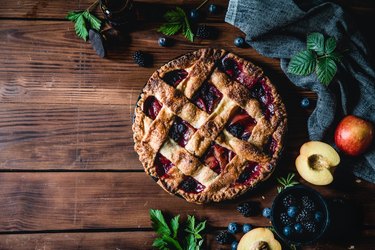
There are so many recipes and ways out there to make pies (hey, you can even bake a pie in the toaster oven), but there's one thing that's certain: It's better to bake pie crust before filling it. And yes — the same goes for savory dinner pies, quiches and other pastries.
Pie fix-ins, like gooey simmered apples, tart preserved cherries, or creamy pureed pumpkin, add moisture that can prevent the crust from turning out how you want it. To achieve that classic, most-beloved flaky crust of your dreams, here's exactly how to prebake pie crust.
Video of the Day
Video of the Day
Tip
Whether you are using ready-made or homemade dough, bake pie crust prior to filling your pie to avoid a soggy bottom.
Why Should I Prebake Pie Crust?
If you're making apple pie or any other type of pie, you should prebake the crust if you want your end result to be flaky. Otherwise, your pie crust could wind up underdone and soggy.
Pie crust can easily get soggy because the filling, usually fruit, releases juices as it bakes. This moistens the dough and prevents it from getting crispy.
Pastry shells filled with creamy custards also may remain soggy after baking. To avoid an unappetizing pie, pre-bake apple pie crust before you fill it. Treat the dough with certain ingredients or employ a classic baking tip or two for the best apple pie recipe.
Tip
You don't have to cook apples, or any other fruits, before using them to fill your pie. But doing so may help you achieve a better result.
To minimize the amount of liquid your fruity pie filling releases during baking, you can try precooking the fruit and pouring off the juice, according to Oregon State University.
If you are baking raw fruit in the pie shell, try mixing it with sugar and letting it sit, which will also cause the juices to release. Then, you can pour the juice off before filling your pie.
How to Prebake Pie Crust (Blind Baking)
There's a name chefs use to describe when you bake a pie crust before filling it: Blink baking.
To blind bake pie crust or any type of pastry crust that gets baked with a wet filling, follow these steps:
- Roll out your dough, transfer it to your pie dish and press it firmly against the bottom and edges.
- Puncture the bottom with a fork to allow heat and steam to move freely and bake the crust.
- Cover the uncooked pie crust with a piece of parchment paper. Pour dry beans of any type on top of parchment paper to keep the crust from bubbling.
- Bake the crust in an oven preheated to 400 degrees Fahrenheit for about 30 minutes or until the edges are golden brown.
- Let the pie shell cool, then add the filling and bake it according to your recipe's instructions. You can cover the crust's edges with aluminum foil to keep them from burning while the filling bakes.
How Long to Pre-Bake Pie Crust
Baking pie crust before you fill it might add to the total time you spend making your recipe, but the result is worth it. The extra step will help you ensure a warm gooey center with a flaky exterior every time.
Blind bake your pie crust in a 400 F oven for about 30 minutes, or until it's a golden brown color. Make sure to allow the crust to cool for at least ten minutes before you add your filling.
Frozen Pie Crust
You can also — and absolutely should — prebake frozen pie crust if you're using it. Most packaging for frozen pie crust will have instructions to help you defrost the crust. This will typically include pricking the bottom of the crust all over with a fork and baking it somewhere between 375 F and 450 F for 10 to 20 minutes.
For specific instructions about the best way to defrost and prebake frozen pie or quiche crust, check the product labeling or visit the manufacturers' website.
Other tips for Baking Pies
Brush the Crust
Brush your uncooked pie crust with egg — yolks or whites — before pouring in the filling. The egg hardens as the pie bakes, creating a moisture barrier between the crust and the filling.
For a no-bake pie, consider brushing the bottom of a cooled, pre-baked shell with chocolate if the taste will enhance your pie's flavor. Let the chocolate cool, which also acts as a moisture barrier, then add your filling.
Bake in Glass
Baking your assembled pie in a glass pie dish is an effective way of monitoring the crust as it bakes, as per Utah State University.
You should also place your pie on your oven's bottom shelf, which puts the pie crust closer to the heat source, allowing it to bake completely. Glass allows you to observe when the bottom of the pie is golden brown. At that point, move the pie to your oven's top shelf so that top can brown as desired.
Rotate the pie periodically while baking to ensure even browning of the crust, as recommended by The Culinary Institute of America.